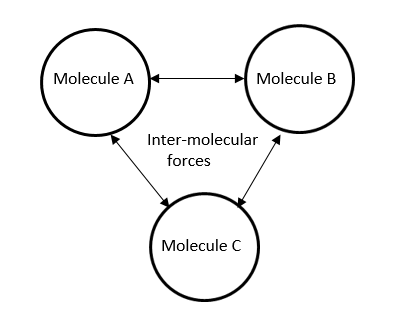
What is the nature of molecular forces?
Answer
543.9k+ views
Hint: Intermolecular forces are the very important one because they determine the physical property of the many objects such as solid, liquid and gas. Intermolecular forces play an important role in science and regular life. Because the hydrogen bond is more important so that the water is produced.
Complete step by step answer:
The force between the molecules is known as intermolecular forces. Intermolecular forces are observed between the atoms and molecules. Intermolecular forces are electrostatic in nature and also having other forces includes van der Waals forces and hydrogen bonds. Based on the intermolecular forces, the object may classify as solid, liquid and gas. In solids, the intermolecular forces are very high. In liquids, the intermolecular forces are slightly less than solids and in gas, the intermolecular forces very less.
In general, there are two types of intermolecular forces. They are Attractive intermolecular forces and Dispersive intermolecular forces. Attractive intermolecular forces are classified into Hydrogen bonding (H-Bonding) and Ionic bonding (Ion-induced dipole forces). Hydrogen bonds are the strongest intermolecular force. Dispersion intermolecular forces are the weakest intermolecular forces.
In solids the particles are arranged in some pattern. So, that the intermolecular forces are very high. In liquids, the particles are close together but not arranged in some pattern. So, that the intermolecular forces are less. But in gas, the particles are very far apart and not in regular arrangement. So, that the intermolecular forces are very less.

Significance of intermolecular forces:
1. Intermolecular forces are the very important one because they determine the physical property of the many objects such as solid, liquid and gas.
2. In solids, the intermolecular forces are attractive in nature. In liquids, the intermolecular forces are slightly attractive and slightly repulsive in nature. But in gas, the intermolecular forces are repulsive in nature.
Note:
The four key intermolecular forces are very important. They are Ionic bond, Hydrogen bond, Van der Waals dipole-dipole interactions, Van der Waals dispersion forces. These are the major and important intermolecular forces. Boiling points are a measure of intermolecular bonds. The intermolecular forces increase with increasing polarization of bonds.
Complete step by step answer:
The force between the molecules is known as intermolecular forces. Intermolecular forces are observed between the atoms and molecules. Intermolecular forces are electrostatic in nature and also having other forces includes van der Waals forces and hydrogen bonds. Based on the intermolecular forces, the object may classify as solid, liquid and gas. In solids, the intermolecular forces are very high. In liquids, the intermolecular forces are slightly less than solids and in gas, the intermolecular forces very less.
In general, there are two types of intermolecular forces. They are Attractive intermolecular forces and Dispersive intermolecular forces. Attractive intermolecular forces are classified into Hydrogen bonding (H-Bonding) and Ionic bonding (Ion-induced dipole forces). Hydrogen bonds are the strongest intermolecular force. Dispersion intermolecular forces are the weakest intermolecular forces.
In solids the particles are arranged in some pattern. So, that the intermolecular forces are very high. In liquids, the particles are close together but not arranged in some pattern. So, that the intermolecular forces are less. But in gas, the particles are very far apart and not in regular arrangement. So, that the intermolecular forces are very less.

Significance of intermolecular forces:
1. Intermolecular forces are the very important one because they determine the physical property of the many objects such as solid, liquid and gas.
2. In solids, the intermolecular forces are attractive in nature. In liquids, the intermolecular forces are slightly attractive and slightly repulsive in nature. But in gas, the intermolecular forces are repulsive in nature.
Note:
The four key intermolecular forces are very important. They are Ionic bond, Hydrogen bond, Van der Waals dipole-dipole interactions, Van der Waals dispersion forces. These are the major and important intermolecular forces. Boiling points are a measure of intermolecular bonds. The intermolecular forces increase with increasing polarization of bonds.
Recently Updated Pages
Class 11 Question and Answer - Your Ultimate Solutions Guide

Master Class 11 Accountancy: Engaging Questions & Answers for Success

Master Class 11 Physics: Engaging Questions & Answers for Success

Master Class 11 Business Studies: Engaging Questions & Answers for Success

Master Class 11 Maths: Engaging Questions & Answers for Success

Master Class 11 Chemistry: Engaging Questions & Answers for Success

Trending doubts
1 ton equals to A 100 kg B 1000 kg C 10 kg D 10000 class 11 physics CBSE

Difference Between Prokaryotic Cells and Eukaryotic Cells

One Metric ton is equal to kg A 10000 B 1000 C 100 class 11 physics CBSE

What is the opposite of entropy class 11 chemistry CBSE

Proton was discovered by A Thomson B Rutherford C Chadwick class 11 chemistry CBSE

1 Quintal is equal to a 110 kg b 10 kg c 100kg d 1000 class 11 physics CBSE




